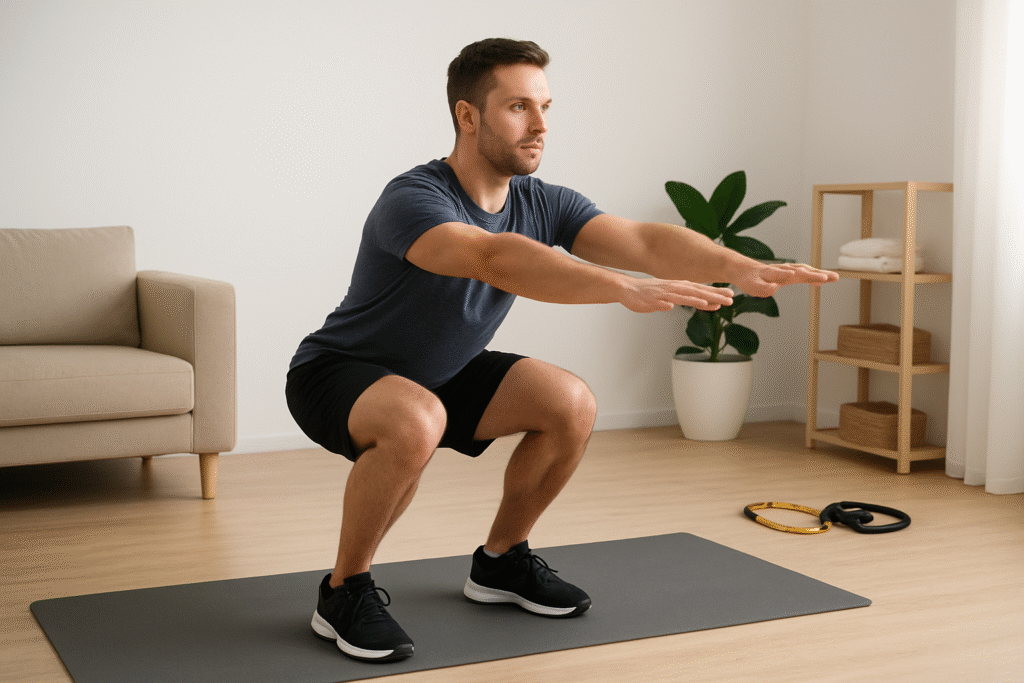
Introduction
Functional strength exercises are more than just workouts—they’re the foundation for better movement, posture, and injury prevention. These exercises train your body to work as a unified system, improving strength and balance in ways that translate directly to everyday activities. Whether you’re lifting groceries, climbing stairs, or playing with your kids, functional strength exercises prepare your muscles and joints to move efficiently and powerfully.
Unlike isolated weight training, functional strength exercises focus on movement patterns that enhance real-world performance. They develop balance, coordination, and flexibility—all essential for maintaining a healthy and active lifestyle. Training functionally doesn’t require a gym or expensive equipment. With just your bodyweight and a small space, you can build endurance, stability, and power at home.
In this guide, we’ll explore the top functional strength exercises you can do at home, their benefits, warm-up routines, and how to progress safely. Let’s build a body that’s not just strong—but functionally strong.
When you start doing functional strength exercises, you train your body to move the way it was made to move. These workouts copy daily actions like bending, lifting, and reaching. For example, squats and lunges build strength for sitting, standing, or climbing stairs. Research shows that functional strength exercises improve balance, posture, and mobility—not just muscle size. (Medical News Today)
Also, doing functional strength exercises at home helps your stabilizer muscles work harder. This improves coordination and lowers your risk of injury. (Live Science) Plus, training this way keeps you active and strong as you age. Studies prove that functional strength workouts reduce fall risk in adults. (MDPI Journal)
.
What Is Functional Strength?
Functional strength refers to your body’s ability to perform daily movements with efficiency, stability, and power. It focuses on improving strength in ways that carry over into real-life activities, such as bending, lifting, pushing, and pulling. The goal is not only to look strong but to move better and prevent injuries.
Every movement involves multiple joints and muscles working together. Functional strength exercises enhance these connections, improving coordination and kinetic chain efficiency. This approach helps your body operate as one cohesive system, not as isolated parts.
Since these moves use your bodyweight, you don’t need any special gear. Just a little space and focus. Start each session with a short warm-up, and end with gentle stretches. These habits help your body recover faster and stay flexible.
With regular practice, functional strength exercises make everyday movement easier. You’ll walk taller, feel stronger, and move with more control. Over time, your stamina, stability, and confidence will all improve
Why Functional Strength Exercises Matter
Functional training strengthens your body for the movements you perform daily. Unlike traditional workouts that target specific muscles, functional strength exercises enhance multiple muscle groups simultaneously. This improves mobility, coordination, and joint health—key factors for longevity and injury prevention.
Proper functional strength helps maintain posture, reduces strain during physical tasks, and increases your overall endurance. It’s training with purpose.
Key Benefits of Functional Training
Builds Real-World Strength
Functional training mimics movements like squatting, twisting, and lifting, which strengthens muscles used in everyday life. This type of strength directly improves activities like carrying groceries, moving furniture, or even gardening.
Enhances Balance and Coordination
Functional exercises train stabilizer muscles and improve neuromuscular control. Better balance reduces your risk of falls and enhances performance in sports and daily movements.
Increases Mobility and Flexibility
Through dynamic and multi-planar movements, functional workouts increase joint range of motion. Improved mobility helps prevent stiffness and supports healthy posture.
Quick 3-Minute Warm-Up for Functional Strength Exercises
Warming up properly prepares your joints, muscles, and nervous system for movement. Here’s a quick routine:
Arm Swings and Shoulder Rolls
Perform 20–30 seconds of arm swings and backward shoulder rolls to loosen your upper body.
Hip Circles and Torso Rotations
Do 10 hip circles each direction followed by gentle torso rotations to activate your core and hips.
Light Dynamic Stretches
Add leg swings, ankle rolls, and gentle lunges to boost blood flow and flexibility.
Main 15-Minute Functional Strength Exercises
Complete 3 rounds of the following functional strength exercises, resting 30–45 seconds between sets.
1. Bodyweight Squats
Targets quads, glutes, and core. Keep your chest up, back straight, and knees aligned over toes. Squats improve leg strength and hip mobility.
2. Push-Ups
Engage your chest, shoulders, triceps, and core. Maintain a straight line from head to heels. Push-ups build upper body strength and stability.
3. Lunges
Enhance balance, coordination, and leg endurance. Step forward, bend both knees to 90°, and push through your front heel.
4. Plank with Shoulder Taps
Hold a plank position and alternately tap your shoulders. Strengthens your core and challenges your balance.
5. Hip Bridge
Lie on your back, knees bent, and lift your hips. Squeeze your glutes and engage your lower back. Great for posture and posterior chain activation.
6. Bear Crawl
Move on hands and toes with knees hovering off the floor. Builds coordination, endurance, and total-body control.
Post-Workout Stretch Routine
Stretching post-workout prevents stiffness and promotes recovery.
Focus on Hips and Shoulders
Perform deep hip flexor stretches and shoulder rolls for mobility and relaxation.
Lower Back Release
Use child’s pose or gentle twists to alleviate tension in the lumbar spine.
Recovery is a vital part of progress, yet many people skip it. After completing your session of functional strength exercises, your muscles need time to adapt and grow stronger. During this phase, your body rebuilds tissues, restores energy, and improves coordination. Because of that, rest days are just as important as training days.
Moreover, adding light movement such as walking or stretching between workouts keeps blood flowing and reduces soreness. These recovery habits make your functional strength exercises more effective over time. In addition, staying hydrated and eating nutrient-rich foods can support muscle repair and energy balance.
As you become consistent, you’ll notice how functional strength exercises improve not only your physical ability but also your posture and confidence. Therefore, think of recovery as part of training, not a break from it. By respecting your body’s need for rest and movement, you’ll gain strength faster, move better, and stay injury-free for longer.
Functional Strength Progressions
Once you’re comfortable with the basics, increase intensity and challenge your coordination.
Add Tempo Variations
Slow down your squats or push-ups to increase time under tension and control.
Combine Movements
Merge squats with shoulder taps or lunges with rotations to mimic complex, real-world motions.
Final Thoughts and Call to Action
Functional strength training builds the foundation for a strong, resilient, and capable body. It enhances the way you move, improves posture, and keeps injuries at bay. Consistency is key—practice these exercises regularly to see noticeable improvements in your balance, endurance, and overall strength.
For continued progress, check out:
- Full Body HIIT Workout at Home: Burn Fat and Build Strength Fast
- 10-Minute Morning Workout to Lose Belly Fat at Home (No Equipment Needed)
Frequently Asked Questions (FAQs)
1. What are functional strength exercises?
They are multi-joint movements that improve strength, coordination, and mobility for everyday tasks.
2. How often should I do functional training?
Three to four sessions per week provide balanced results without overtraining.
3. Do I need equipment for functional strength exercises?
No. Bodyweight movements are highly effective, but resistance bands or dumbbells can add variety.
4. Can functional training help with weight loss?
Yes. It increases calorie burn, builds lean muscle, and improves metabolic health.
5. How long before I see results?
With consistency, noticeable strength and posture improvements appear within 3–4 weeks.
6. Can beginners do functional strength exercises?
Absolutely. Start with controlled movements and progress gradually as your strength improves.

